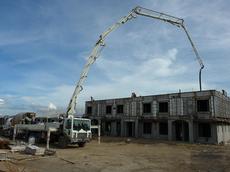Why concrete tends to thicken
Researchers at the ETH Zurich have unraveled the microscopic mechanism behind shear thickening: the increase in viscosity with speed observed for dense particle suspensions under flow. The study has a direct impact on the cement industry.

Suspensions of particles need to be moved through pipes and processed in many industrial applications. Often, as in the case of the cement industry, the liquid content needs to be reduced as much as possible, to achieve the desired material properties. Above a certain solid fraction, the resulting dense suspensions display an increase in the viscosity under flow — so-called continuous shear thickening. This implies that the power needed for concrete to be sent faster along a pipe increases more rapidly with speed than for simple fluids like water, leading to very high costs when pumping concrete over long distances in large building sites, e.g. when building skyscrapers.
Moreover, under certain circumstances the viscosity of the flowing paste may increase infinitely at a given speed—a phenomenon called discontinuous shear thickening—resulting in severe processing problems, such as pumping failures. In order to tackle these problems, the French cement giant, Lafarge contacted the ETH Laboratory for Surface Science and Technology in the Department of Materials, headed by Prof. Nicholas Spencer.
A new unified model
Combining laboratory experiments and numerical simulations, Nicolas Fernandez and Roman Mani, two doctoral students in the groups of Prof. Spencer and of Prof. Hans J. Hermann in the ETH Department of Civil, Environmental and Geomatic Engineering, have initiated a quest to understand the origin of shear thickening in dense pastes, as models for concrete flow.
The key to their work has been the realization that the flow of such dense systems is dominated by the contacts between flowing grains, and therefore that the rheology (flow) of the pastes is intimately related to their tribological (friction) properties. By unifying these aspects, the researchers have discovered that the onset of the viscosity increase is linked to the transition between two types of lubrication between grains. At sufficiently low speeds, the contacts between particles in the suspension are lubricated by a liquid film (hydrodynamic regime). As the particles flow faster, this lubrication film breaks down and the surfaces of the grains come into direct contact and their friction is analogous to the case of dry grains—a regime known as boundary lubrication. This microscopic lubrication transition lies at the origin of shear thickening. For sufficiently high solid fractions and friction coefficients, boundary-lubricated flows may also be impossible, so that when the lubricating fluid film breaks down, viscosity increases to infinity, and the system undergoes discontinuous shear thickening.
“The main result of this work is that for the first time we have a unified model to explain the occurrence and the nature of the shear-thickening transition in granular pastes.” commented Lucio Isa, Assistant Professor for Interfaces, Soft matter and Assembly at ETH. “Moreover, the link between discontinuous shear thickening and boundary friction makes it possible to delay or avoid the former by tuning the friction between grains, which has direct, practical implications for the cement industry.”
Lower friction, easier flow
Experiments have indeed demonstrated that the coefficient of friction between particles can be easily controlled by polymeric additives. The polymers bind to the surface of grains and coat the particles with a “dense brush”, which lowers the friction coefficient. Combined rheology and tribology tests confirmed that polymers yielding lower boundary friction coefficients allow for flows at higher solid fractions without discontinuous shear thickening. This discovery opens up possibilities for industries to tune and optimize the flowability of dense pastes at high speed simply by surface modifying the cement grains via the addition of very small amounts of polymers.
Reference
Fernandez N. et al. Microscopic Mechanism for Shear Thickening of Non-Brownian Suspensions, Physical Review Letters, 111, 108301 (2013), doi:10.1103/PhysRevLett.111.108301







READER COMMENTS